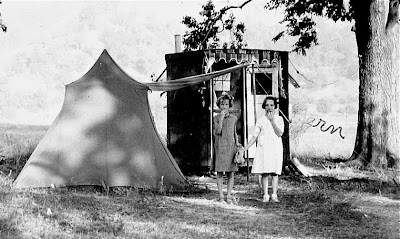HISTORY THROUGH HOUSES
In July of 1982, my mother and I made a nostalgic trip back to her hometown and birthplace, Fennimore, Wisconsin. Fennimore held special memories for me also, as I spent a couple years of my very early childhood there and later spent enjoyable summers on my grandparent's farm.
My Mother's Birthplace
On January 8, 1906, a brown eyed dark haired baby was born to Will and Mary Riddiough on a farm just south of Fennimore. She was to be the oldest of their four daughters. In the picture above, the buildings can barely be seen from the road.
Mother's Home in 1925
Mother and Father were married in 1926 at her parents home (above). This is where she lived in 1925 and was most likely the site of her wedding, February 16 ,1926.
The Tuckwood House
The Tuckwood house sits on a corner in Fennimore. This is the house that my mother and father moved to when Fern and I were small (from 1933-1935). Fern was 3-5 years old and I was 1-3 years old). I remember Fern and I having chicken pox when living in this house. Fern loves to tell the story about when mom and dad were having a prayer session in the small living room with my father's sister and her husband, Hazel and Roy Wauchope. The Wauchopes were very religious and our mother felt sure they did not approve of bad or off-color language. The door to the upstairs where Fern and I were playing on the steps (as children sometimes do) opened into the living room. Somehow, Fern slipped and came tumbling down the steps and hit the door at the bottom of the steps. The door flew open with the impact and she landed into the room. My sister immediately picked herself and uttered a resounding "OH SHIT! Everyone stared in surprise then laughed. Fern expected to receive a spanking for her faux pas, but it never came much to her relief.
Retirement Home of Carl and Marie Fischer
Mother's grandparents, Carl and Marie Fischer, lived in a house not too far from the Tuckwood house after their retirement from farming. I remember it being painted brown. It was a sad occasion when mother's aunt Edith suffered a stroke and died. I do remember a visit to the house during that time, but nothing else ... have no recollections of Carl and Marie. Fern and I were each a given juice size glass to remember her by. I still have mine.
Happy Summers on the Farm
My grandfather, Will Riddiough, moved from farm to farm during his lifetime. Pictured above is the last one on which they lived for many years. It hold so many memories of my summers on the farm. My job was to go to the mailbox and get the mail each day. Playing with all the kittens and the Collie cow dog, Scotty, kept me more than occupied. My job, along with Scotty, was to go and bring the cows in for evening milking. Actually, the well trained cow dog did all the rounding up and driving to the barnyard. I just followed along. I was eight years old when my grandfather saddled up Tops, hoisted me aboard and sent me happily plodding along in the pasture warbling my favorite cowboy songs. I was in cowgirl heaven. Tops was a plow horse, though grandfather referred to her as his "western horse". Looking back she was most likely a large quarter horse. I never saw him ride, but he did have all the gear necessary. I spent hours currying Tops when she was stabled in the barn.
My love affair with horses started at an early age.
The Orchard Farm 1926


This is the first farm that my mother and father moved onto after their marriage on February 16, 1926. It was called The Orchard Farm. Times were hard, and I don't think my father enjoyed farming that much. They, too, moved from farm to farm. After the 1929 crash, they left farming and moved to Illinois where they both worked at and orphanage call "The Youman City of Childhood". Mother worked in the kitchen and dad worked in the diary milking cows as I recall.
Homeless for a while ..... Fern with friend. Fern and I slept in the trailer.
Mom and Dad slept in the tent.
Mom and Dad slept in the tent.
Cabin at Krause Kabin Kourt
My parents moved to La Crosse in 1937 where they lived in a tent and trailer for a few months then moved into a one room cabin with cement floors then in a two room house in Green Acres where Fern and I spent our early childhood. In 1940, they bought the four room house on Barlow Street where they would live until my father's death in 1981. Notice the Model A Ford ... that was my Father's.
Green Acres ... Fern and I standing in the doorway.
Our job was to help de-bud all the peony bushes and pick
strawberries and raspberries ... a condition put forth
by the landlord, Frank Moore.
Our job was to help de-bud all the peony bushes and pick
strawberries and raspberries ... a condition put forth
by the landlord, Frank Moore.
Thanks to Scott, I have a picture of the house on Barlow Street. Railings had been added to the front stoop, but the house looks pretty much the same as when Fern and I lived there.

















